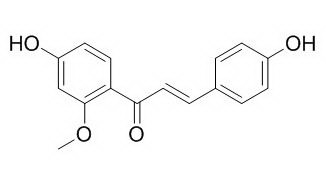2'-O-Methylisoliquiritigenin
2'-O-Methylisoliquiritigenin, a compound synthesized by enzymes specifically induced in NR.
Inquire / Order:
manager@chemfaces.com
Technical Inquiries:
service@chemfaces.com
Tel:
+86-27-84237783
Fax:
+86-27-84254680
Address:
1 Building, No. 83, CheCheng Rd., Wuhan Economic and Technological Development Zone, Wuhan, Hubei 430056, PRC
Providing storage is as stated on the product vial and the vial is kept tightly sealed, the product can be stored for up to
24 months(2-8C).
Wherever possible, you should prepare and use solutions on the same day. However, if you need to make up stock solutions in advance, we recommend that you store the solution as aliquots in tightly sealed vials at -20C. Generally, these will be useable for up to two weeks. Before use, and prior to opening the vial we recommend that you allow your product to equilibrate to room temperature for at least 1 hour.
Need more advice on solubility, usage and handling? Please email to: service@chemfaces.com
The packaging of the product may have turned upside down during transportation, resulting in the natural compounds adhering to the neck or cap of the vial. take the vial out of its packaging and gently shake to let the compounds fall to the bottom of the vial. for liquid products, centrifuge at 200-500 RPM to gather the liquid at the bottom of the vial. try to avoid loss or contamination during handling.
Front Microbiol.2023, 14:1232039.
Molecules.2021, 26(13):4081.
J of Liquid Chromatography & Related Technologies2024, 47(1-5):14-25.
Eur J Pharmacol.2024, 975:176644.
Plants (Basel).2021, 10(11):2317.
J Food Composition and Analysis2022, 104417.
Biochem Biophys Rep.2024, 40:101830.
Chem Biol Interact.2019, 315:108910
PLoS One.2017, 12(8):e0181191
Korean Journal of Pharmacognosy.2020, 51(2):100-106
Related and Featured Products
Molecular Plant Pathology, 2015, 16(9):973-986.
Transcriptome analysis highlights preformed defences and signalling pathways controlled by the prAe1 quantitative trait locus (QTL), conferring partial resistance to Aphanomyces euteiches in Medicago truncatula.[Reference:
WebLink]
METHODS AND RESULTS:
To gain an insight into the molecular mechanisms of quantitative disease resistance in Medicago truncatula to the root-infecting oomycete Aphanomyces euteiches, we selected two near-isogenic lines (NILs), NR and NS, partially resistant and susceptible, respectively, differing in the allelic state of the quantitative resistance locus (QRL) prAe1 (partially resistant to A. euteiches 1). Complementary molecular and cytological phenotyping methods showed that prAe1 alone confers quantitative resistance to A. euteiches. Root and stem tissues were colonized in NS plants and 80% of NS plants died by 21 days post-inoculation (dpi). In contrast, A. euteiches mycelium was restricted to the root cortex and the spread of symptoms was arrested in aerial parts of NR plants. A transcriptome analysis performed at 0, 1 and 6 dpi identified 1198 differentially expressed genes (DEGs) between NR and NS lines. More than 87% of the DEGs were significantly more expressed in NR. The highest number of DEGs was found in control conditions, with 723 genes over-expressed in NR versus 85 in NS. Genes belonging to secondary metabolism, pathogenesis-related (PR) proteins and kinases were significantly enriched. The significant role of the flavonoid pathway in resistance was corroborated by the detection of larger amounts of flavonoids in NR roots and the inhibition of A. euteiches zoospore germination by 2'-O-Methylisoliquiritigenin, a compound synthesized by enzymes specifically induced in NR.
CONCLUSIONS:
Our study revealed that prAe1-dependent resistance relies mainly on the constitutive expression of defence-related pathways and signalling elements, which can be re-amplified in later time points of the infection.



